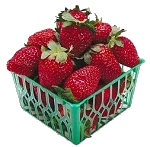Most Contaminated: The
Dirty Dozen Consistent with two
previous EWG investigations, fruits
topped the list of the consistently most contaminated fruits and
vegetables, with eight of the 12 most contaminated foods. Among
the top six were four fruits, with peaches leading the list, then
strawberries, apples and nectarines. Pears, cherries, red
raspberries, and imported grapes were the other four fruits in the
top 12. Among these eight fruits:
- Nectarines had the highest percentage
of samples test positive for pesticides (97.3 percent), followed
by pears (94.4 percent) and peaches (93.7 percent).
- Nectarines also had the highest
likelihood of multiple pesticides on a single sample — 85.3
percent had two or more pesticide residues — followed by peaches
(79.9 percent) and cherries (75.8 percent).
- Peaches and raspberries had the most
pesticides detected on a single sample with nine pesticides on a
single sample, followed by strawberries and apples, where eight
pesticides were found on a single sample.
- Peaches had the most pesticides
overall with some combination of up to 45 pesticides found on
the samples tested, followed by raspberries with 39 pesticides
and apples and strawberries, both with 36.
Spinach, celery, potatoes, and sweet bell
peppers are the vegetables most likely to expose consumers to
pesticides. Among these four vegetables:
- Celery had the highest of percentage
of samples test positive for pesticides (94.5 percent), followed
by spinach (83.4 percent) and potatoes (79.3 percent).
- Celery also had the highest likelihood
of multiple pesticides on a single vegetable (78 percent of
samples), followed by spinach (51.8 percent) and sweet bell
peppers (48.5 percent).
- Spinach was the vegetable with the
most pesticides detected on a single sample (10 found on one
sample), followed by celery and sweet bell peppers (both with
nine).
- Sweet bell peppers were the vegetable
with the most pesticides overall with 39, followed by spinach at
36 and celery and potatoes, both with 29.
|
Least Contaminated: Consistently Clean
The vegetables least likely to have
pesticides on them are sweet corn, avocado, cauliflower,
asparagus, onions, peas and broccoli.
- Nearly three-quarters (73 percent) of
the pea and broccoli samples had no detectable pesticides. Among
the other vegetables on the least-contaminated list, there were
no detectable residues on 90 percent or more of the samples.
- Multiple pesticide residues are
extremely rare on any of these least contaminated vegetables.
Broccoli had the highest likelihood, with a 2.6 percent chance
of more than one pesticide when ready to eat. Avocado and corn
both had the lowest chance with zero samples containing more
than one pesticide when eaten.
- The greatest number of pesticides
detected on a single sample of any of these low-pesticide
vegetables was three as compared to 10 found on spinach, the
most contaminated crop with the most residues.
- Broccoli and onions both had the most
pesticides found on a single vegetable crop at up to 17
pesticides but far fewer than the most contaminated vegetable,
sweet bell peppers, on which 39 were found.
The five fruits least likely to have
pesticide residues on them are pineapples, mangoes, bananas, kiwi
and papaya.
- Fewer than 10 percent of pineapple and
mango samples had detectable pesticides on them and fewer than
one percent of samples had more than one pesticide residue.
- Though 53 percent of bananas had
detectable pesticides, multiple residues are rare with only 4.7
percent of samples containing more than one residue. Kiwi and
papaya had residues on 23.6 percent and 21.7 percent of samples,
respectively, and just 10.4 percent and 5.6 percent of samples,
respectively, had multiple pesticide residues.
|


